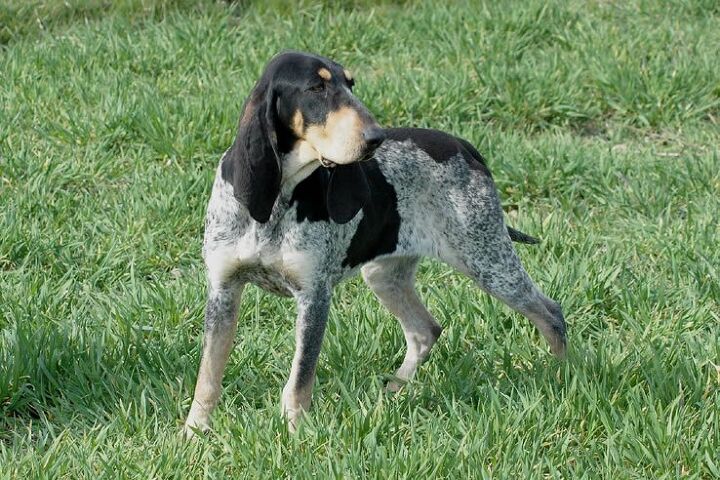Petite Bleu De Gascogne


About Petite Bleu De Gascogne
Though the name might suggest the Petite Bleu de Gascogne is a small-breed dog, that isn’t the case. This medium-sized breed is a scent hound of French origin, named for its proficiency in hunting small game. These dogs are particularly skilled in hunting rabbits and, while more common than its larger relative the Grand Bleu de Gascogne, the Petite Bleu de Gascogne is still fairly rare outside of France and is not yet recognized by the AKC.
The Petite Bleu de Gascogne is a scent hound of French origin, named for its proficiency in hunting small game.
The Petite Bleu de Gascogne is one of several French scenthounds descendant from the St. Hubert Hound. This breed is of the Bleu de Gascogne type which is one of the oldest purebred dog breeds in the world and a rarity even in France. The breed type was developed during the Middle Ages and hunting became popular among French nobility and it was bred in different sizes for different types of game.
The Petite Bleu de Gascogne was specifically bred down in size from the Grand Bleu de Gascogne to hunt smaller game. This began sometime around the 1500s and the breed continues to be used for this purpose today. A talented pack hunter, the Petite Bleu de Gascogne is thought to have been used in the development of other hound breeds which may include the Petit Griffon Bleu de Gascogne and the Basset Bleu de Gascogne.
The Petite Bleu de Gascogne is descendant from the St. Hubert Hound and bred down in size from the Grand Bleu de Gascogne.
As a medium-sized breed, the Petite Bleu de Gascogne should do well on a high-quality adult dog food with high protein and moderate fat content. Because the breed is typically used for hunting, however, he may fare better on an active or working breed formula made with quality animal proteins, healthy fats, and digestible carbohydrates.
The Petite Bleu de Gascogne is a hard-working breed.
The Petite Bleu de Gascogne is a hard-working breed like others of its type and it has the typical pack hound mentality. This means that these dogs are bred to hunt with other dogs and that requires a certain degree of independence. This breed is not necessarily difficult to train, but you do need to understand that the breed will be fairly independent-minded and is generally not a good fit for inexpeirneced dog owners and for purposes other than hunting. You’ll see the best results if you execute a firm and consistent hand in training this breed, knowing that the breed is unlikely to be completely compliant at all times.
The Petite Bleu de Gascogne is a medium-sized breed, standing 20 to 23 inches tall and weighing an average of 40 to 50 pounds.
The Petite Bleu de Gascogne is by no means an aggressive breed, but you should expect some dominance behavior with other dogs if you’re adding him to an existing pack. This breed is generally good with other dogs once they get used to each other, but he may not be a good choice for homes with cats or other small animals due to his hunting instincts. These dogs are friendly with people and can be devoted to their owners, but their stubborn nature requires a fair bit of obedience training and socialization. This breed does best when trained for hunting, though he may be adaptable to family life as long as his exercise needs are met, and he still has an opportunity to use his hunting skills.
For the most part, the Petite Bleu de Gascogne is a healthy breed. One thing you should be wary of, however, is the risk for ear infections that comes with pendulous ears. Other potential health problems may include hip and elbow dysplasia, tooth decay, allergies, and bloat.
The average lifespan for the Petite Bleu de Gascogne is 10 to 12 years.
As a hunting breed, the Petite Bleu de Gascogne has high needs for exercise that need to be met on a daily basis. If this breed doesn’t get enough exercise, it is likely to develop problem behaviors such as becoming destructive and becoming very vocal. These dogs are also smart and trainable, so mental stimulation should be part of their daily exercise as well.
The Petite Bleu de Gascogne is by no means an aggressive breed, but you should expect some dominance behavior with other dogs if you’re adding him to an existing pack.
Though it is not currently recognized by the AKC, the Petite Bleu de Gascogne was recognized by the United Kennel Club in 1991 as a scent hound.
The Petite Bleu de Gascogne has a short coat that is not difficult to groom – weekly brushing is generally enough to control shedding. In terms of coloration, these dogs are white mottled with black, having a slate-like appearance. They also exhibit black patches on the sides of the head and across the back, often with tan markings above the eyebrows.
The average litter size for the Petite Bleu de Gascogne is 4 to 7 puppies. As a hunting breed, puppies should be started with training as early as possible. If you hope to keep this breed as a pet, early socialization is extremely important – especially for homes with children and non-canine pets. Start your Petite Bleu de Gascogne puppy with a high-quality puppy food and switch to an adult or working breed formula after 12 months of age.

Kate Barrington is the loving owner of two cats (Bagel and Munchkin) and a noisy herd of guinea pigs. Having grown up with golden retrievers, Kate has a great deal of experience with dogs but labels herself a lover of all pets. Having received a Bachelor's degree in English, Kate has combined her love for pets and her passion for writing to create her own freelance writing business, specializing in the pet niche.
More by Kate Barrington























